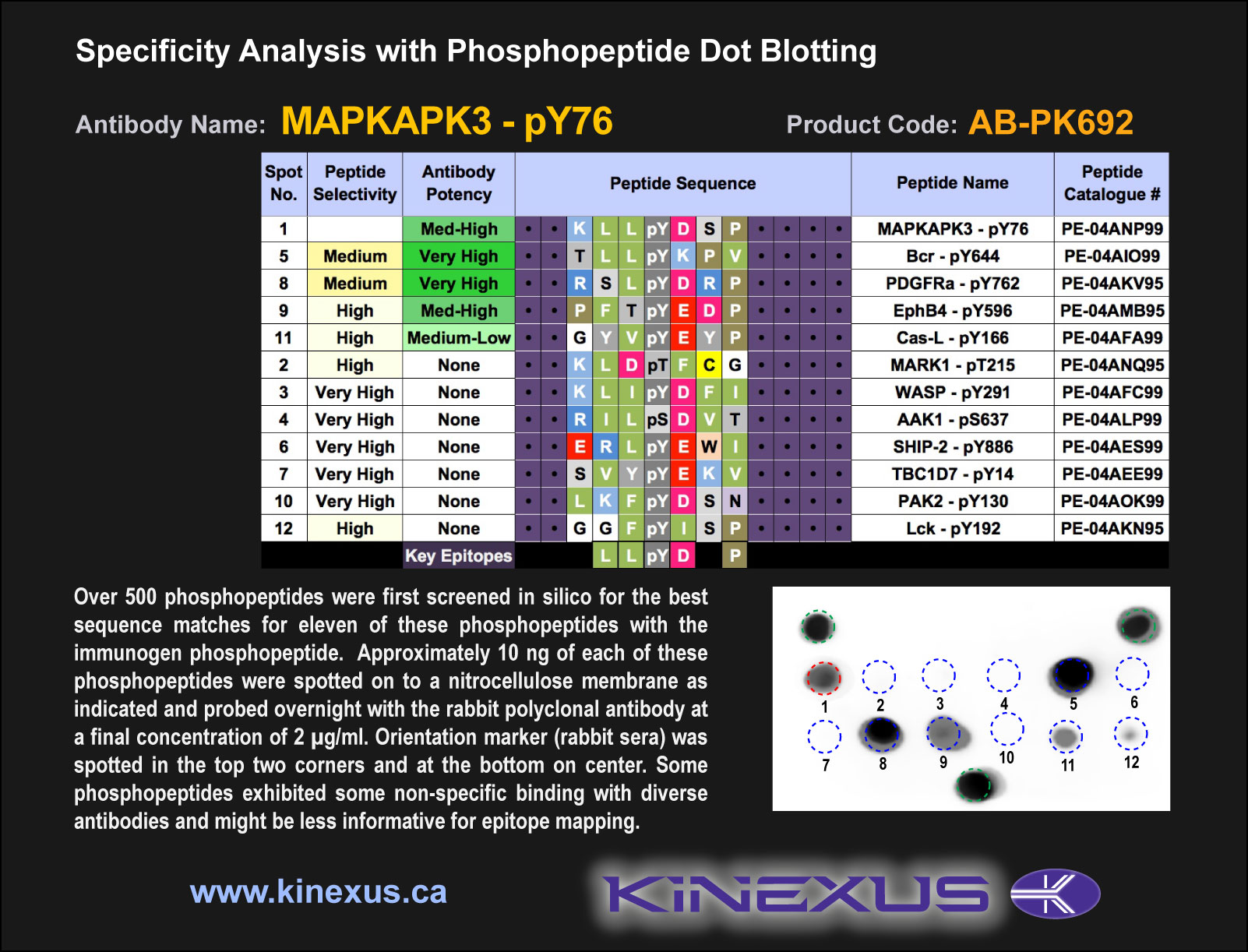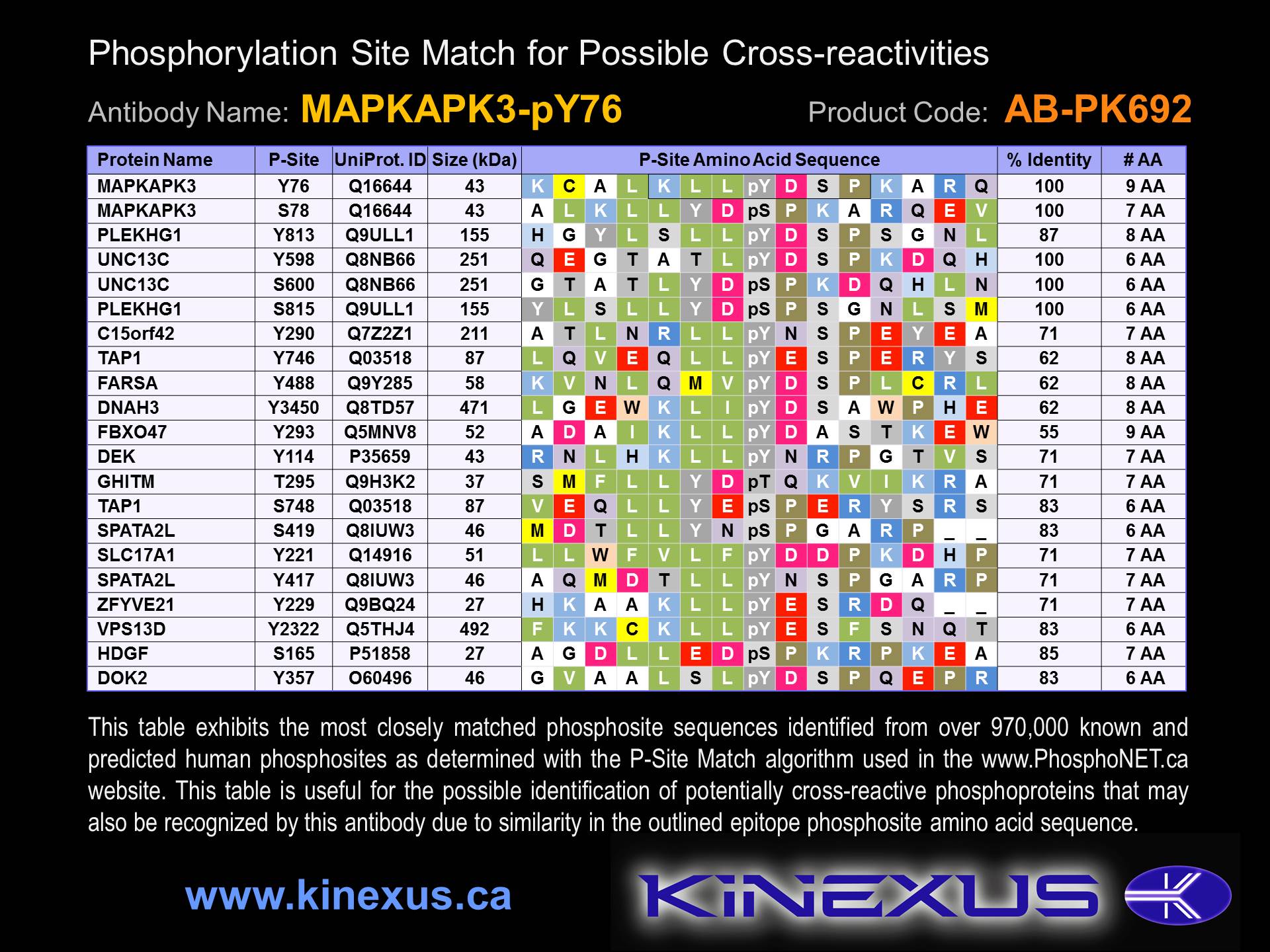Product Name: MAPKAPK3-pY76
Product Number: AB-PK692
| Size: | 25 µg | Price: | 89.00 | |
| $US |
Target Full Name: MAP kinase-activated protein kinase 3
Target Alias: 3PK; 54r; MAPK3; MAPKAP3; Mitogen activated protein kinase activated protein kinase-3; CCDS2832.1; ENSG00000114738
Product Type Specific: Protein kinase phosphosite-specific antibody
Antibody Code: PK692
Antibody Target Type: Phosphosite-specific
Antibody Phosphosite: Y76
Protein UniProt: Q16644
Protein SigNET: Q16644
Antibody Type: Polyclonal
Antibody Host Species: Rabbit
Target Alias: 3PK; 54r; MAPK3; MAPKAP3; Mitogen activated protein kinase activated protein kinase-3; CCDS2832.1; ENSG00000114738
Product Type Specific: Protein kinase phosphosite-specific antibody
Antibody Code: PK692
Antibody Target Type: Phosphosite-specific
Antibody Phosphosite: Y76
Protein UniProt: Q16644
Protein SigNET: Q16644
Antibody Type: Polyclonal
Antibody Host Species: Rabbit
Antibody Immunogen Source: Human MAPKAPK3 sequence peptide Cat. No.: PE-04ANP99
Antibody Immunogen Sequence: KLL(pY)DSP(bA)C
Antibody Immunogen Description: Corresponds to amino acid residues K73 to P79; In the protein kinase catalytic domain in subdomain II. This is the major in vivo site of phosphorylation of MAPKAPK3.
Antibody Immunogen Sequence: KLL(pY)DSP(bA)C
Antibody Immunogen Description: Corresponds to amino acid residues K73 to P79; In the protein kinase catalytic domain in subdomain II. This is the major in vivo site of phosphorylation of MAPKAPK3.
Production Method: The immunizing peptide was produced by solid phase synthesis on a multipep peptide synthesizer and purified by reverse-phase hplc chromatography. Purity was assessed by analytical hplc and the amino acid sequence confirmed by mass spectrometry analysis. This peptide was coupled to KLH prior to immunization into rabbits. New Zealand White rabbits were subcutaneously injected with KLH-coupled immunizing peptide every 4 weeks for 4 months. The sera from these animals was applied onto an agarose column to which the immunogen peptide was thio-linked. Antibody was eluted from the column with 0.1 M glycine, pH 2.5. Subsequently, the antibody solution was neutralized to pH 7.0 with saturated Tris.This antibody was also subject to negative purification over phosphotyrosine-agarose.
Antibody Modification: Unconjugated. Contact KInexus if you are interest in having the antibody biotinylated or coupled with fluorescent dyes.
Antibody Modification: Unconjugated. Contact KInexus if you are interest in having the antibody biotinylated or coupled with fluorescent dyes.
Antibody Concentration: 1 mg/ml
Storage Buffer: Phosphate buffered saline pH 7.4, 0.05% Thimerasol
Storage Conditions: For long term storage, keep frozen at -40°C or lower. Stock solution can be kept at +4°C for more than 3 months. Avoid repeated freeze-thaw cycles.
Product Use: Western blotting | Antibody microarray
Antibody Dilution Recommended: 2 µg/ml for immunoblotting
Antibody Potency: Very strong immunoreactivity with immunogen peptide on dot blots.
Antibody Species Reactivity: Human
Antibody Positive Control: The observed molecular mass of the processed target protein on SDS-PAGE gels is reported to be around 40-45 kDa.
Storage Buffer: Phosphate buffered saline pH 7.4, 0.05% Thimerasol
Storage Conditions: For long term storage, keep frozen at -40°C or lower. Stock solution can be kept at +4°C for more than 3 months. Avoid repeated freeze-thaw cycles.
Product Use: Western blotting | Antibody microarray
Antibody Dilution Recommended: 2 µg/ml for immunoblotting
Antibody Potency: Very strong immunoreactivity with immunogen peptide on dot blots.
Antibody Species Reactivity: Human
Antibody Positive Control: The observed molecular mass of the processed target protein on SDS-PAGE gels is reported to be around 40-45 kDa.
Related Product 1: MAPKAPK3-pY76 blocking peptide
Related Product 2: MAPKAPK2-pT222 phosphosite-specific antibody (Cat. No.: AB-PK690)
Related Product 3: MAPKAPK2-pY225+pT226 phosphosite-specific antibody (Cat. No.: AB-PK691)
Related Product 4: MAPKAPK5-pT186 phosphosite-specific antibody (Cat. No.: AB-PK693)
Related Product 5: HSP27 (81-86) KinSub - Based on Heat shock protein 27 (L81-S86, mouse) peptide; HSP27tide protein kinase substrate peptide
Related Product 6: MAPKAPK3Subtide - MAPKAPK2 protein kinase substrate peptide
Related Product 2: MAPKAPK2-pT222 phosphosite-specific antibody (Cat. No.: AB-PK690)
Related Product 3: MAPKAPK2-pY225+pT226 phosphosite-specific antibody (Cat. No.: AB-PK691)
Related Product 4: MAPKAPK5-pT186 phosphosite-specific antibody (Cat. No.: AB-PK693)
Related Product 5: HSP27 (81-86) KinSub - Based on Heat shock protein 27 (L81-S86, mouse) peptide; HSP27tide protein kinase substrate peptide
Related Product 6: MAPKAPK3Subtide - MAPKAPK2 protein kinase substrate peptide
Scientific Background: MAPKAPK3 is a protein-serine/threonine kinase that is a member of the CAMK group of protein kinases in the MAPKAPK family, and MAPKAPK subfamily. This kinase is highly expressed and widely distributed in most tested human tissues. MAPKAPK3 is activated by growth inducers and stress stimulation of cells. It can mediate cytokine production, cell migration, endocytosis, remodeling chromatin, and regulation of transcription. Some targets that MAPKAPK3 phosphorylate include HSP27/HSPB1, KRT18, KRT20, RCSD1, RPS6KA3, TAB3 and TTP/ZFP36. MAPKAPK3 interacts with TCF3 and with polycomb proteins, such as PCH2 and BMI1/PCGF4. MAPKAPK3 affinity to PCH2 can be increased with a K73M mutation. In vitro studies have demonstrated that ERK1/2, p38 MAP kinase and Jun N-terminal kinase were all able to phosphorylate and activate this kinase, which supports the role of MAPKAPK3 as an integrative element of signalling in both mitogen and stress responses. MAPKAPK3 might be a tumour suppressor protein (TSP). It is proposed to be deleted in some small cell lung cancers, but this remains to be proven in an in vivo (and not only cell line) model. MAPKAPK3 has also been linked with the development of glioblastoma multiforme (GM). However, the near absence of reported somatic mutations in this protein indicates that it may function as a tumour requiring protein (TRP) in many human tumours.
Figure 1. Epitope mapping of MAPKAPK3-pY76 antibody with similar phosphopeptides on dot blots.
Figure 2. Identification of phosphosites related to MAPKAPK3-pY76.
© Kinexus Bioinformatics Corporation 2017



